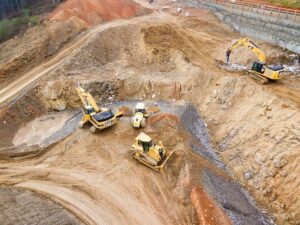Expert Soil Compaction for Sitework in Kentucky: Ensuring Stable Foundations and Durable Construction
Site soil compaction forms the backbone of any durable structure by increasing soil density to support heavy loads, control settlement, and improve drainage under foundations and pavements. As a critical sitework process, it transforms loose or disturbed subgrade into a stable platform that underpins roads, commercial slabs, and residential footings. This article explores what soil compaction is and why it matters, examines the compaction needs of different soil types, reviews the most effective methods and equipment, outlines quality testing procedures, and introduces complementary stabilization techniques for challenging ground conditions. Along the way, you’ll discover how Earth Works, LLC leverages its excavation and grading expertise, top-of-the-line machinery, and rigorous quality controls to deliver foundation soil compaction solutions across Kentucky while keeping projects on schedule and within budget.
What Is Soil Compaction and Why Is It Essential for Sitework?
Soil compaction is the engineered process of densifying earth materials by reducing air voids through mechanical effort, thereby increasing load-bearing capacity and structural integrity. By applying controlled energy—often via rollers or rammers—compaction mechanisms reposition soil particles into a tighter fabric that resists settlement and frost heave. For example, during subgrade preparation for a commercial slab, a vibratory roller systematically densifies granular fill to achieve a uniform platform capable of supporting heavy equipment without excess deflection, setting the stage for reliable construction.
Proper compaction delivers five core benefits for sitework:
- Enhanced load-bearing capacity to support foundations and pavement
- Reduced settlement risk that prevents cracking and structural distress
- Improved drainage performance by controlling permeability and avoiding water pooling
- Increased frost resistance in Kentucky’s seasonal freeze-thaw cycle
- Minimized voids and erosion potential to extend service life
These advantages underpin every excavation and grading operation before transitioning into detailed soil-type considerations.
How Does Soil Compaction Improve Load-Bearing Capacity and Structural Integrity?
Effective compaction increases the density of foundation soils, boosting stiffness and shear strength so that imposed loads distribute evenly without excessive deformation. When subgrade voids are eliminated and particles are interlocked, bearing capacity rises substantially—often by 25–50 percent compared to loose fill—providing a firmer platform for footings, floor slabs, and pavements that resists differential settlement and maintains alignment under dynamic and static loads.
What Are the Common Problems Caused by Poor Soil Compaction?
- Uneven settlement leading to cracks in foundations, walls, and slab edges
- Water ingress and poor drainage that weaken subgrade under load
- Frost heave in cold months causing pavement buckling and slab movement
- Erosion of uncompacted fill resulting in voids and instability
- Increased maintenance costs to repair uneven surfaces and structural damage
Addressing these issues at the compaction stage averts expensive remedial work and schedule delays.
How Does Soil Compaction Affect Drainage and Settlement in Construction Projects?
By tightly packing soil grains, compaction controls permeability and directs subsurface water flow away from critical structural elements. A properly compacted subgrade exhibits predictable drainage characteristics, preventing perched water tables and reducing settlement variability. This stability ensures that foundations and pavement sections remain level and durable over decades rather than requiring frequent leveling or repair.
Which Soil Types Require Specific Compaction Techniques for Sitework?
Different soils demand tailored compaction strategies to reach optimum density, as grain shape, size distribution, and cohesion vary widely between clay, silt, and sand. Recognizing soil behavior under load allows project managers to select the correct equipment, apply the right moisture content, and achieve consistent results across a site. Understanding these distinctions is essential before moving on to compaction equipment options.
Each soil category requires specific moisture control and equipment choices to reach its maximum dry density, paving the way for optimal compaction validation methods.
How Do Cohesive and Granular Soils Differ in Compaction Needs?
Cohesive soils like clay rely on kneading action to collapse plate-like particles, whereas granular soils require vibratory energy to rearrange individual grains into a denser packing. Cohesive compaction focuses on lower-frequency, higher-amplitude passes to break soil bonds, while granular compaction uses high-frequency vibrations to settle particles, illustrating two distinct mechanistic approaches.
What Is the Role of Optimum Moisture Content in Soil Compaction?
Optimum moisture content (OMC) balances surface tension and lubrication between particles, allowing maximum soil density under applied energy. Below OMC, soils remain too stiff to rearrange; above OMC, excess water fills voids and prevents full compaction. Laboratory Proctor tests identify this critical moisture threshold to guide field operations and ensure compaction efficiency.
How Does Soil Testing Inform the Selection of Compaction Methods?
Pre-construction soil testing—including Proctor and sieve analyses—provides insights into particle size distribution, plasticity, and moisture-density relationships. These test results inform the choice of roller type, compactive effort, and lift thickness, enabling project teams to tailor compaction procedures to on-site conditions and achieve specifications reliably.
Expert Kentucky Soil Compaction Solutions for Durable Construction
Sitework soil compaction methods employ a range of heavy-plant and handheld machinery to match soil type, lift thickness, and project scale. From large-scale vibratory rollers to compact rammers, each method applies specific energy patterns that densify earth materials efficiently. Equipment selection must balance productivity, uniformity, and ground access before delving into individual tools.
How Are Vibratory Rollers Used for Granular Soil Compaction?
Vibratory rollers combine static weight with high-frequency oscillations to settle granular fills by fluidizing particles into a denser arrangement. On road bases and large commercial pads, multiple passes at optimal amplitude progressively reduce void ratios, ensuring uniform compaction across wide swaths of subgrade.
When Should Padfoot Rollers Be Used for Cohesive Soil?
Padfoot rollers exert kneading pressure via projecting “foot” segments that punch through cohesive soils, breaking down aggregates and forcing finer particles to interlock. For clay-rich subgrades, this method optimizes density while minimizing shear strain that could otherwise induce cracking.
What Roles Do Plate Compactors and Tamping Rammers Play in Sitework?
Plate compactors and tamping rammers deliver concentrated energy to confined areas, making them ideal for trench backfill, around utilities, and in tight corners. Plate compactors spread energy over a wider area, while rammers focus high-impact blows on deeper lifts, complementing larger rollers.
How to Choose the Right Compaction Equipment for Your Project?
Equipment choice hinges on soil classification, lift height, site accessibility, and production requirements. For extensive earthworks with granular fill, vibratory rollers maximize coverage. Cohesive soils benefit from padfoot action, and tight spaces require plate or rammer units. Matching these attributes ensures consistent density and project efficiency.
How Is Soil Compaction Quality Tested and Verified on Construction Sites?
Quality control in compaction hinges on field and laboratory methods that confirm density and moisture targets are met. By systematically testing at specified intervals and locations, project teams verify compliance with design specifications and Kentucky construction standards. Accurate verification guides adjustments in compaction effort and moisture management before subsequent lifts proceed.
What Is the Proctor Test and How Does It Determine Optimum Moisture Content?
The Proctor test is a laboratory procedure that compacts soil samples at varying moisture levels and measures resulting dry density to identify the moisture content that yields maximum density. This optimum moisture content becomes a benchmark for field compaction, ensuring crews add water or allow drying to achieve the targeted soil behavior.
How Does the Sand Cone Test Measure Soil Density?
In the field, the sand cone test quantifies in-place density by excavating a known volume of soil, replacing it with calibrated sand, and calculating the mass difference. This direct measurement confirms that compaction lifts meet specified dry densities and guides further compaction or rework if values fall below targets.
The sand-cone method is a widely accepted procedure for determining the in-situ density of soil.
The Sand-Cone Method for In-Situ Soil Density Determination
The sand-cone method is a widely accepted procedure for determining the in-situ density of soil. The test involves excavating a hole, filling it with a calibrated sand, and measuring the volume of sand used. This volume is then used to calculate the in-situ density of the soil. The sand-cone method is suitable for most soil types, but it can be challenging to use in very wet or very dry conditions.
Effect of wetting conditions on the in situ density of soil using the sand-cone method, SS Park, 2021
What Is the Role of Nuclear Density Gauges in Soil Compaction Verification?
Nuclear density gauges use radiometric methods to measure moisture and density nearly instantaneously, offering rapid quality checks across multiple lifts. By correlating radiation counts to soil properties, these gauges enable frequent testing with minimal site disruption, accelerating decision-making and confirming compaction uniformity.
Nuclear density gauges offer a non-destructive means of assessing soil compaction and verifying proper soil compaction for improving the performance and longevity of structures.
Nuclear Density Gauges for Verifying Soil Compaction in Foundations
Density is a direct measure of the compaction of soils in the foundations of structures such as roads, airfields, buildings, and earthworks. The in-place density of soil can be measured using various methods, including nuclear density gauges. These gauges provide a non-destructive means of assessing soil compaction and verifying proper soil compaction for improving the performance and longevity of structures.
A new low-activity nuclear density gauge for soil density measurements, 2022
How Do These Tests Ensure Compliance with Kentucky Construction Standards?
Rigorous adherence to ASTM and AASHTO test protocols ensures that compaction results satisfy state infrastructure requirements and project specifications. Consistent testing and documentation demonstrate due diligence for regulatory inspections and provide accountability for general contractors and project stakeholders.
While nuclear gauges offer rapid checks, other methods like penetrometers can be less reliable on compacted or dry soils, highlighting the importance of selecting appropriate verification tools.
Measuring Soil Compaction on Construction Sites: Gauges versus Penetrometers
This paper reviews two techniques for determining soil compaction on construction sites. The surface nuclear gauge is suitable for measuring soil compaction in soils with less than 5% organic matter by weight and at a depth of no more than 0.15 m (6 in.). Penetrometer readings are often unreliable on compacted soils, as well as in dry and stony soil conditions. Therefore, the penetrometer is rarely a valuable device on construction sites as a definitive measurement instrument, but it may be useful as an indicator of compacted areas. Recommendations for measuring soil compaction on construction sites are provided.
Measuring soil compaction on construction sites: A review of surface nuclear gauges and penetrometers, TB Randrup, 2001
What Soil Stabilization Techniques Complement Soil Compaction for Challenging Site Conditions?
When native soils lack sufficient strength or exhibit high plasticity, stabilization techniques enhance ground performance before or after compaction. Chemical binders and mechanical reinforcement integrate with compaction to improve bearing capacity, control shrink-swell behavior, and extend the service life of subgrades in demanding environments.
How Does Lime Stabilization Improve Weak Soils?
Lime reacts with clay particles to reduce plasticity, increase pH, and promote pozzolanic reactions that form cementitious compounds. This process enhances unconfined compressive strength, reduces swelling potential, and improves workability, preparing weak soils for subsequent compaction passes.
What Are the Benefits of Cement Stabilization in Sitework?
Cement stabilization binds soil grains through hydration reactions, creating a rigid matrix that resists deformation and water infiltration. In road base and slab subgrades, cement-treated layers achieve high durability and load-bearing capacity while limiting moisture-related movement.
How Do Geogrids and Mechanical Stabilization Enhance Soil Strength?
Geogrids and geotextiles introduce high-strength polymer meshes into the soil mass, distributing loads and preventing lateral movement of compaction lifts. Mechanical stabilization reduces rutting and increases shear resistance, particularly under heavy traffic applications.
When Should Soil Stabilization Be Considered in Kentucky Construction Projects?
Projects on expansive clay, organic soils, or reclaimed land benefit most from stabilization when native subgrade fails to meet density or strength requirements after standard compaction. Early testing and geotechnical evaluation identify these conditions, guiding decisions on lime, cement, or geosynthetic reinforcement.
How Does Earth Works, LLC Deliver Expert Soil Compaction Services Across Kentucky?
Earth Works, LLC provides comprehensive sitework services across Central and Western Kentucky, integrating excavation, grading, and compaction into a cohesive workflow that supports foundations, roads, and utilities. By combining experienced operators, proven processes, and top-tier equipment, the company ensures reliable performance from initial subgrade preparation through final compaction certification.
What Advanced Equipment and Techniques Does Earth Works, LLC Use?
Leveraging vibratory and padfoot rollers alongside plate compactors and nuclear gauge technology, Earth Works, LLC applies data-driven compaction strategies tailored to soil type and project scale. Real-time moisture monitoring and GPS-guided grading enhance precision, reduce rework, and accelerate project timelines.
How Does Earth Works, LLC Ensure Project Efficiency and Budget Compliance?
A structured quality management plan combines test-driven compaction schedules with proactive moisture control to meet density targets on the first pass. This systematic approach minimizes additional passes, cuts fuel consumption, and keeps projects aligned with planned budgets and schedules.
What Are Examples of Successful Soil Compaction Projects in Lexington and Louisville?
In Lexington, a mixed-use development benefited from sequential padfoot and vibratory compaction that achieved uniform density across varying soil strata, avoiding costly corrective measures. In Louisville, Earth Works, LLC delivered a heavy-industrial pad where nuclear gauge verifications confirmed compliance at every lift, ensuring a trouble-free foundation for specialized operations.
How Can General Contractors and Builders Benefit from Partnering with Earth Works, LLC?
General contractors and builders gain confidence on-time delivery, consistent compaction results, and clear documentation that supports inspection approvals. Collaborative planning, transparent reporting, and local expertise combine to make Earth Works, LLC a trusted partner for soil compaction in Kentucky.
What Are the Most Frequently Asked Questions About Soil Compaction for Sitework?
General queries around site soil compaction often focus on its definition, methodology, and equipment selection. Clients frequently seek clarity on how compaction improves bearing capacity, which tests verify density, and when stabilization becomes necessary. Understanding these fundamentals empowers project teams to specify accurate compaction requirements, avoid common pitfalls, and budget appropriately for testing and specialized equipment.
Concerns also arise regarding over-compaction risks—excessive densification that impedes drainage—and long-term benefits such as reduced maintenance and enhanced structural durability. Recognizing the balance between sufficient and excessive compaction, and knowing the role of moisture control, helps stakeholders optimize subgrade performance and secure lasting foundation stability.
Foundational soil compaction underpins sitework excellence, and partnering with a seasoned specialist ensures that these critical operations integrate seamlessly into broader construction workflows across Kentucky.
A well-compacted subgrade not only meets today’s performance standards but also safeguards project longevity and cost-effectiveness for decades of service.


